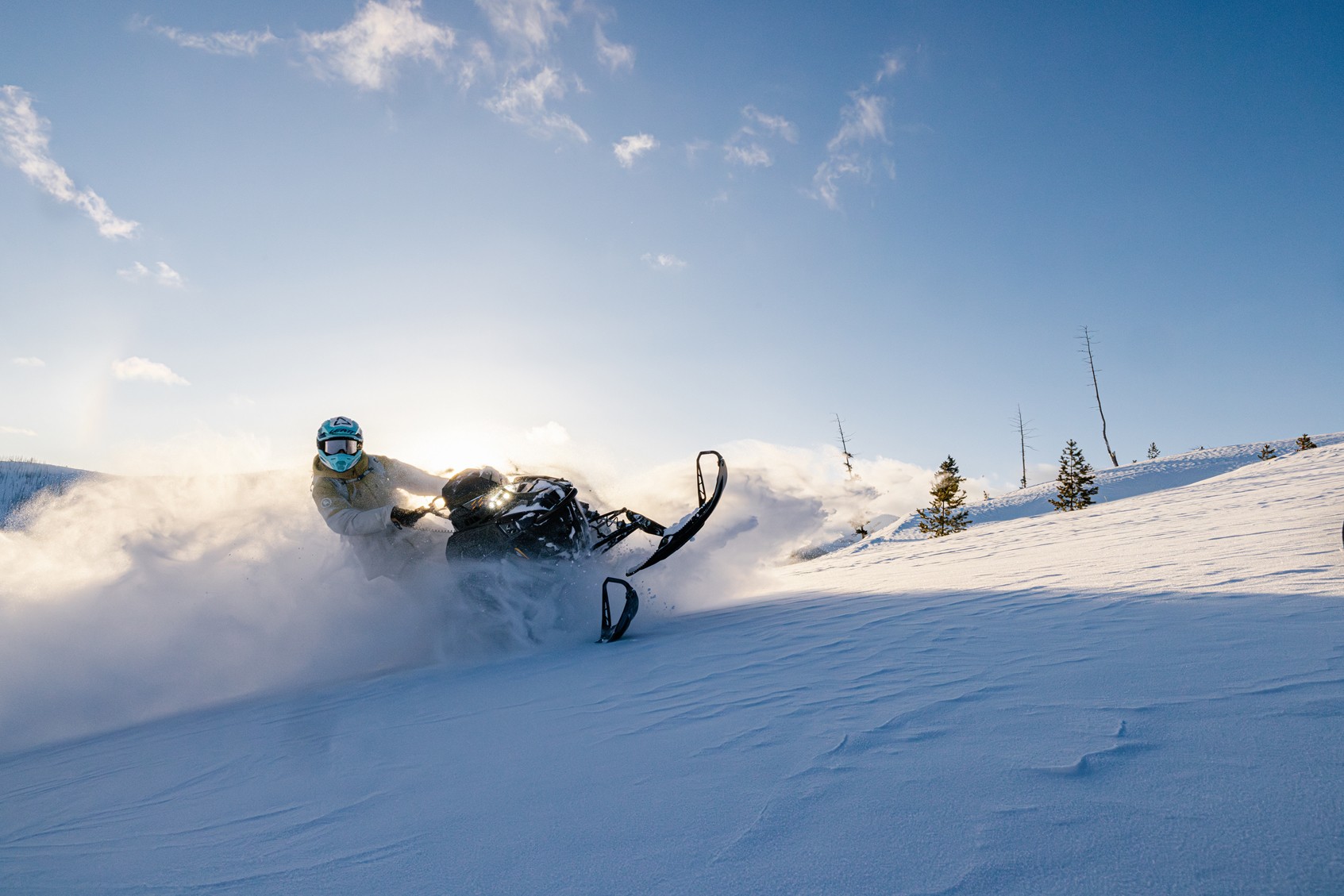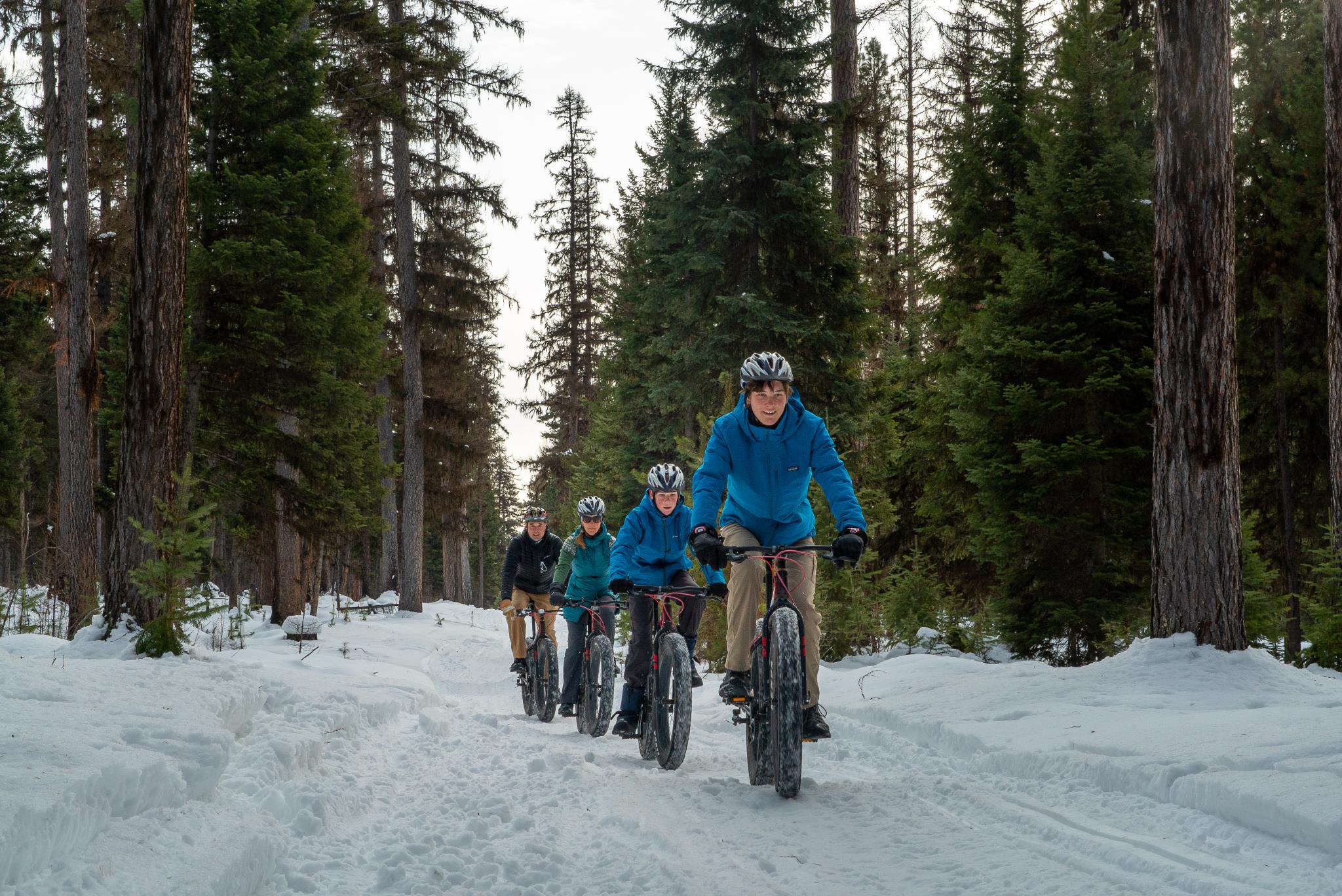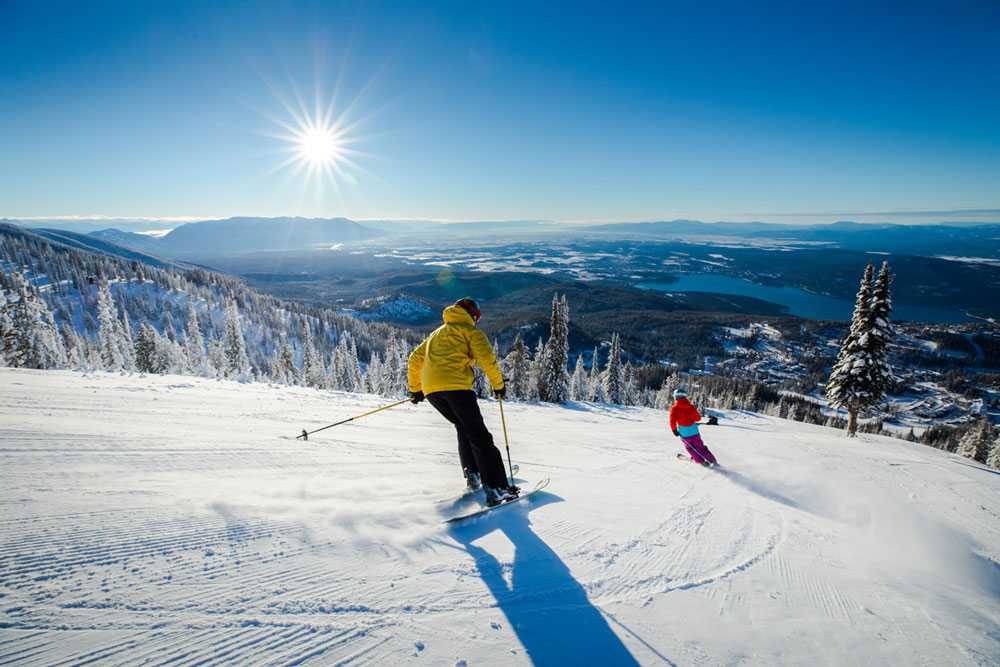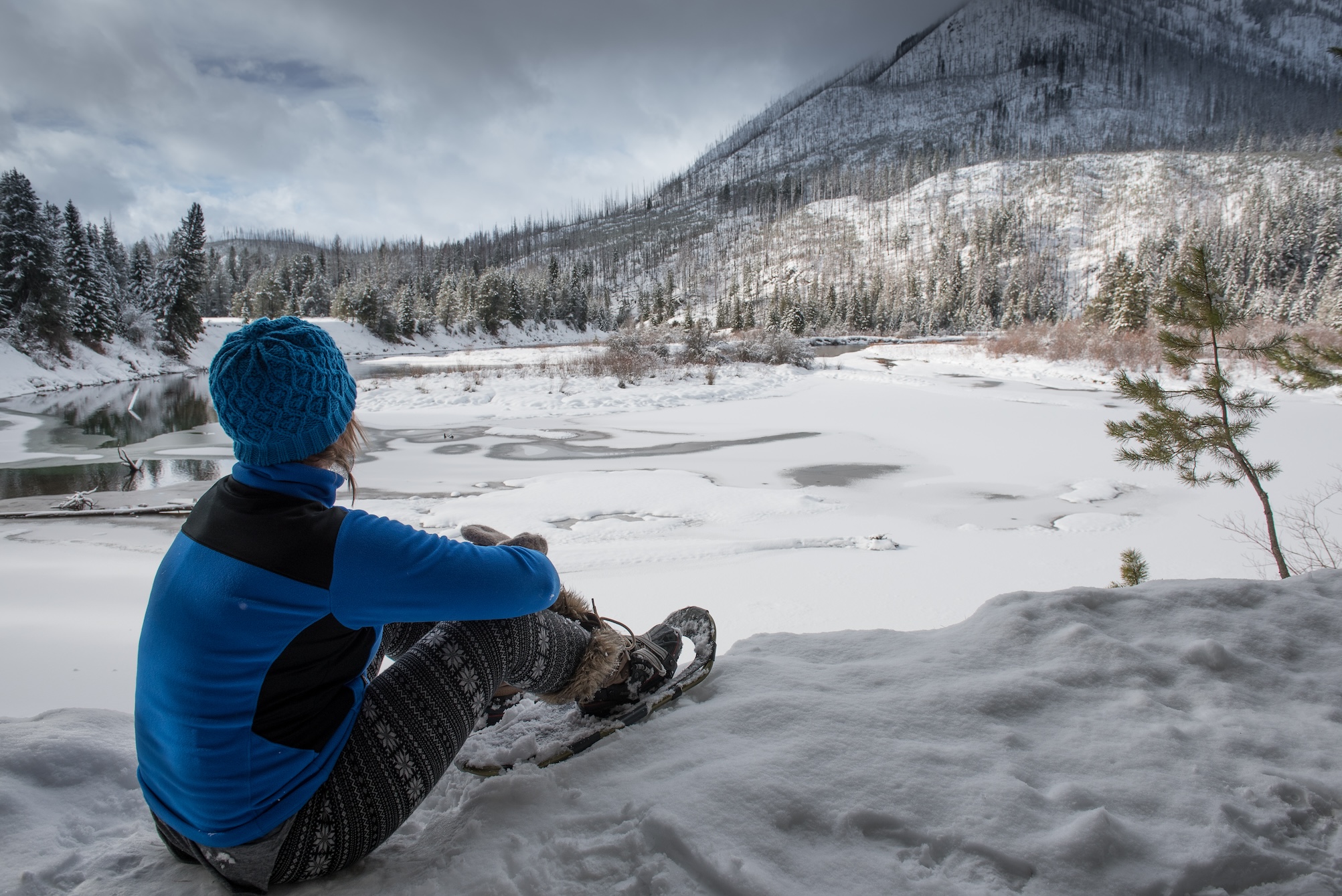How to Approach the Outdoors and Recreate Responsibly
Content shared with permission from RecreateResponsibly.org, Tread Lightly!, Leave No Trace Center for Outdoor Ethics and Flathead Rivers Alliance.
RECREATE RESPONSIBLY VIDEO
RECREATE RESPONSIBLY DURING THE WINTER
Spending time in outdoor spaces is very popular around here, and we sure are grateful for the quality and quantity of outdoor space we have in Western Montana. It's paramount, however, that we all do our part to recreate responsibly when playing in local parks, on public lands and trails, in Montana’s two national parks, and everywhere in between, including our small towns.
Western Montana's Glacier Country is a partner in the national Recreate Responsibly initiative to provide all outdoor lovers the outlook to experience safe, responsible and successful outdoor adventures, and to preserve the places we all love.
We are also proud to partner with Tread Lightly!, in the initiative to protect and enhance access to recreation and opportunities for the motorized recreationalist, and with Leave No Trace, to minimize human impacts on the outdoors.
Spend time learning about our local gems and find off-the-beaten-path spots to explore. Use state and federal land websites like TrailLink, AllTrails, FarOut, and local meetup/Facebook/stewardship groups, or check out library books on local outdoor resources to find them.
As we embrace new places and new ways to get outside, we have a responsibility to think about our impact on the outdoors and to be a part of sustaining them for the future. This means:
- Know the rules and safety information for the area you're exploring, especially in regard to avalanches in the wintertime.
- Be willing to turn around when areas are too crowded.
- Practice responsibility around wildlife: This means keeping a safe distance and never approaching, touching or feeding wildlife.
- Take a Tread Lightly! course or Leave No Trace course.
It takes all of us working together to be good stewards to this great state. Here are some helpful resources to learn more about what Recreate Responsibly, Leave No Trace, and Tread Lightly! mean, and how to practice them while enjoying our great outdoors and fresh mountain air.

- Know Before You Go
- Play It Safe
- Explore Mindfully
- Keep Our Waters Clean
- Leave No Trace
- Tread Lightly
- Follow Fire Safety
- Be Wildlife Wise
- Respect Tribal Lands
Know Before You Go
Plan Ahead and Be Prepared
Adequate research, planning and preparation ensure safer, more enjoyable travels—especially in the wild and unpredictable outdoors—and minimize your impact on Montana’s resources and lands. Poor planning can lead to missed experiences, frustration, and when recreating can cause unintended damage to special places.
BEFORE YOU HEAD OUT:
Know what’s open and when.
Check business hours in advance; some business are seasonal only and/or have limited hours. Glacier National Park is open year round, but not all park roads and park concessionaires are open year round. Some state parks are day-use only.
Secure reservations in advance.
Book airfare, lodging, campsites, rental cars, shuttles, tours and restaurant reservations ahead of time. Montana is not the kind of place where you should “wing it,” especially in the summer months.
Be aware of fire restrictions.
Before you head out, know what fire restrictions (and stages) are in place, if any, and follow them accordingly.
Know the weather forecast.
Check travel updates and the weather forecast before you head out. Weather and temperatures can change very quickly and drastically, especially in higher altitudes. Knowing the forecast also helps with packing the right gear.
Consider your skill level and activity limits when planning activities.
That peak might be calling your name, but before planning a summit or strenuous hike, consider your limits and abilities.
Map your route and share your location.
Know your driving, hiking and biking and backcountry routes, and let friends and family know where you’ll be.
Know what to wear and pack.
Wear activity-appropriate clothing and footwear, and pack the right gear for your activity. Layers are essential.
Travel responsibly with pets.
If you’re traveling with your dog in Western Montana, know where they are and are not permitted and follow posted regulations. Dogs are not allowed on most trails in Glacier National Park. If you are planning on traveling in other parts of the region with your dog, it should be properly licensed and up-to-date on vaccines. Aggressive pets should be left at home. Bring dog waste bags and pick up dog waste promptly. Always dispose of waste in proper receptacles, which you’ll often find near trails. If you don’t find a proper receptacle, you’ll need to carry the waste out with you. Make sure your dog doesn’t chase wildlife; this could harm wildlife, your dog or even you—or your dog could get lost. Make sure you carry enough food and water for you and your dog while you’re out exploring, and note that pets are not allowed on some public lands and waterways, and in other areas they must be leashed.
PLAY IT SAFE
Pack the Right Gear and Know Your Limits
There are some essential steps you can take for staying safe while recreating in Montana’s great outdoors any time of year, from general safety knowledge to avalanche safety and water safety. Please plan ahead to play it safe.
GENERAL SAFETY
- Stick to activities that fit your skill level.
- Know your physical limitations.
- Always travel with ample water and provisions.
- Be cognizant of the dangers of water, whether moving or still. Drowning is the No. 1 cause of death in Glacier National Park where the water is very, very cold.
- Stay a safe distance from all wildlife; they are wild for a reason—they can be unpredictable and dangerous. Know how to recreate in bear country.
- Have a first-aid kit in your car or backpack.
AVALANCHE SAFETY
We’re very serious about our backcountry terrain around here. We’re also very serious about backcountry safety. The wild and rugged nature of Montana’s high country should never be an afterthought, especially when it’s covered in snow. Avalanche safety should always be top of mind when you’re headed back into the deep stuff, whether via ski, snowboard, snowshoe or snowmobile. Proper gear and know-how are everything.
Here are some recommendations for avalanche safety:
Go With a Guide
Play it safe with a backcountry ski or snowmobile tour. Your guide knows best when it comes to avalanche safety.
Stay In Bounds at Ski Resorts
When recreating at ski resorts, don't ski or sled the backcountry on your own unless it is permitted AND you are up-to-date on the avalanche forecast, own and know how to use the right avalanche safety gear, and have adequate training.
Get Educated in Avalanche Safety
Know before you go. Take a course in avalanche safety, which will teach you the basics of avalanche safety gear, snow testing, avalanche awareness and avalanche rescue. Avalanche safety education includes courses for motorized and non-motorized snowsports. Courses in avalanche safety are offered online and in the field.
To find courses and education resources, visit:
- avalanche.org
- KBYG - Know Before You Go
- AIARE Avalanche Research + Education
- Tread Lightly!
- Missoula Avalanche
- Flathead Avalanche Center
Check Avalanche Forecasts
Always check the local avalanche forecast before you recreate in the backcountry, and understand what it means. The U.S. and Canada use a five-category avalanche danger estimation system. This North American Avalanche Danger Scale allows avalanche forecasters to communicate avalanche threat—low, moderate, considerable, high, extreme.
Visit avalanche.org for conditions and warnings. For local Western Montana avalanche conditions, advisories and information, visit Missoula Avalanche and the Flathead Avalanche Center.
Carry Avalanche Gear
Learn what gear you need for the backcountry, get the right gear, and know how to use it. This is critical. Find the beacon, shovel, probe and airbag pack that are right for you.
Avalanche beacons (or transceivers) transmit your location so others can find you or you can find them in the aftermath of an avalanche.
Avalanche shovels are essential for backcountry recreation. They can be used to dig out persons buried by snow, but they are also necessary for studying snowpack and digging emergency shelters.
Probes are also essential pieces of backcountry gear. These lightweight, folding poles help you determine how deep the snow is and, in the case of an avalanche rescue, where to begin digging.
Airbag packs feature a bladder that, when pulled, inflates to keep you closer to the surface during an avalanche.
Please note that having avalanche safety gear does not mean you should be reckless and recreate in areas where the avalanche threat is anything but low.
Know Your Snow
Avoid avalanches by learning where and why they occur. Learn to recognize the red flags of an unstable snowpack, which indicate avalanche danger. These include signs of a recent avalanche, or signs of unstable snow. Recent heavy snowfall or rain, or a rapid increase in above freezing temperatures, also creates unstable snow and increases the likelihood of avalanches.
Among other avalanche safety gear, snow study tools and kits are essential pieces of backcountry equipment to determine the safety of the snowpack, but are not an alternative to checking the avalanche forecast before you head out, which is vital.
Engage in Backcountry Sports Responsibly
Learn more about recreating responsibly while playing in the deep stuff, including backcountry skiing, snowboarding, snowshoeing and camping. Read more tips about responsible backcountry snowsports from our friends at Tread Lightly!
WATER SAFETY
In additional to knowing how to swim, please wear a personal floatation device (PFD) while boating, floating and paddling. Ensure your chosen activity matches your skill level and water comfort level. Always bring the appropriate gear you need for your specific water activity. Please note that Montana waters can be cold year-round thanks to snowmelt. Don't drink alcohol while recreating in and on the water. We highly recommend recreating with a friend or group. As always, check the weather before you head out. Note: Montana’s waters are cold year round. Drowning is the No. 1 cause of death in Glacier National Park, where the waters are frigid.
Swimming Safety
Our rivers and lakes make the perfect place to cool off on a hot summer day, but please make sure you know how to swim, and take the following precautions:
- Only swim in designated swimming areas.
- When in doubt, get out.
- Know the conditions.
- Never swim alone.
- Choose the right equipment.
- Understand currents.
- Don’t mix swimming and alcohol.
- Wear a USCG-approved life vest.
- Have a plan for emergencies.
- Swim parallel to the shore.
- Learn more about these important 10 open water safety tips.
Boating Safety
There are multiple ways to boat and float Montana’s waterways. That means many different types of recreators may be sharing a boating area. Please recreate responsibly by operating your boat at safe speeds and keeping an adequate distance from others. Give sailboats and other non-motorized craft a wide berth. Read more about boating safety here.
River and Stream Safety
Montana is known for world-class river recreation, drawing anglers, rafters and floaters from far and wide. To ensure a memorable experience, play it safe by being prepared with the right gear, understanding river flows and currents and being prepared for water hazards. Read more about river and stream safety here.
EXPLORE MINDFULLY
Be Thoughtful and Aware
Exploring local parks, trails and public spaces is a privilege that comes with responsibility. Being mindful of your impact on these environments ensures they remain enjoyable for everyone.
Be part of an inclusive outdoors. We all play a role in helping to make sure our great outdoors are safe and welcoming for all abilities and identities by being kind, respectful and patient.
Please be mindful of our communities and small businesses. They may be short staffed. Support our communities by patronizing local establishments with kindness, patience and respect.
Respect fellow adventurers. Keep in mind that others might have different—but valid and safe—ways of enjoying the outdoors.
Be good stewards of our public lands. Never recreate on private land without permission.
KEEP OUR WATERS CLEAN
Help Prevent Aquatic Invasive Species
Preserving the health of Montana’s waters is imperative to safeguarding the delicate balance of aquatic ecosystems. Aquatic Invasive Species (AIS)—non-native plants, animals or pathogens—pose a significant threat to Montana's environment and economy. Preventing their spread is crucial.
AIS are introduced accidentally or intentionally outside of their native range. AIS populations can reproduce quickly and spread rapidly because there are no natural predators or competitors to keep them in check. AIS can displace native species, clog waterways, impact irrigation and power systems, degrade ecosystems, threaten recreational fishing opportunities and can cause wildlife and public health problems.
If you plan to recreate on Montana’s waterways, know:
- What AIS inspections are required if you bring your own boat.
- If you use a watercraft of any kind (motorized and nonmotorized) while here, follow three simple steps: Clean.Drain.Dry.
VIDEO: Montana Invasive Species
LEAVE NO TRACE
Minimize Your Impact
We believe in being good stewards of our destination, balancing our culture, natural environment, and quality of life and experience—protecting the very qualities that make Western Montana first and foremost a wonderful place to live, with the added benefit of being a wonderful place to visit.
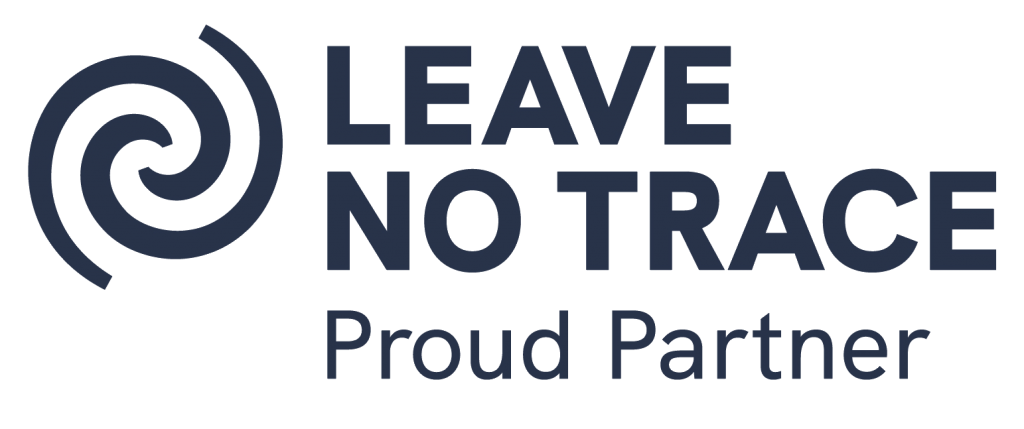
Western Montana’s Glacier Country is a proud partner of Leave No Trace, the most widely used stewardship education program on public lands across Montana. The program has been shown to reduce recreation related impacts and continues to inspire millions of visitors each year through the easy to practice Seven Principles of Leave No Trace. Think you know Leave No Trace? Take the free online course Leave No Trace: Take Action to Protect the Outdoors and find out!
TREAD LIGHTLY Take the CoursePlease respect all public lands, waterways, tribal lands and local communities by:
- Planning Ahead and Preparing to minimize avoidable impacts.
- Travel and Camp on Durable Surfaces to allow ecosystems to thrive.
- Dispose of Waste Properly to keep Montana free of litter and garbage—this includes things like cigarette butts, cherry pits, fruit rinds and making sure your firepit is clear of trash.
- Leave What You Find and reduce the spread of insect and other aquatic invasive species.
- Minimize Campfire Impacts to prevent catastrophic wildfires.
- Respect Wildlife to protect yourself, as well as the livelihood of Western Montana’s iconic wild animals.
- Be Considerate of Others so that the outdoors can be a healthy, inviting and inclusive experience for everyone.
Leave No Trace Resources
- Leave No Trace website
- Leave No Trace YouTube Video Library
- Leave No Trace Research and Resources
©Leave No Trace Center for Outdoor Ethics
TREAD LIGHTLY
Take Care of Our Trails and Waterways
When recreating on motorized vehicles, we can ensure our trails, rivers and lakes are accessible, healthy and beautiful for all to enjoy. Please do your part by staying in designated areas and keeping trails and waterways clean and litter free, minimizing your impact. Take the initiative to understand and uphold responsible recreation practices tailored to your specific motorized activities.

Western Montana’s Glacier Country is proud to partner with Tread Lightly! in the initiative to protect and enhance access to recreation and opportunities for the motorized recreationalist. The program teaches outdoor ethics and best practices through recreate responsibly messaging for specific motorized sports along with the T.R.E.A.D Principles. Being responsible doesn’t mean being boring. Educate yourself now with the free Tread Lightly! 101 Online Awareness Course.
TREAD LIGHTLY Take the CourseBy working together as one motorized community, we can keep our trails open, healthy and beautiful for generations to come. Do your part by keeping trails clean and trash free, and educating yourself on ways to ride responsibly specific to your motorized activity below:
Tread Lightly! Resources
- Tread Lightly! website
- Tread Lightly! education
- Tread Lightly! stewardship
I Ride, I Drive, I Off-Road, I Tread Lightly!
FOLLOW FIRE SAFETY
Help Prevent Wildland Fires
Western Montana is susceptible to wildland fire, especially during the dry summer months. Following campfire safety is crucial. Preventable wildland fires threaten lives, wild animals and their habitat, property, and our precious natural resources.
Whether it is properly extinguishing a campfire or keeping your vehicle maintained to prevent sparks, following just a few simple steps can help prevent wildland fires. Learn how to properly use outdoor equipment; burn debris safely; maintain, and extinguish a campfire; maintain a vehicle and tow safely; and practice fire-safe target shooting, to name a handful. If you are traveling in the summer, know what fire restrictions are in place at your destination and check if campfires, barbeques and flammables are allowed.
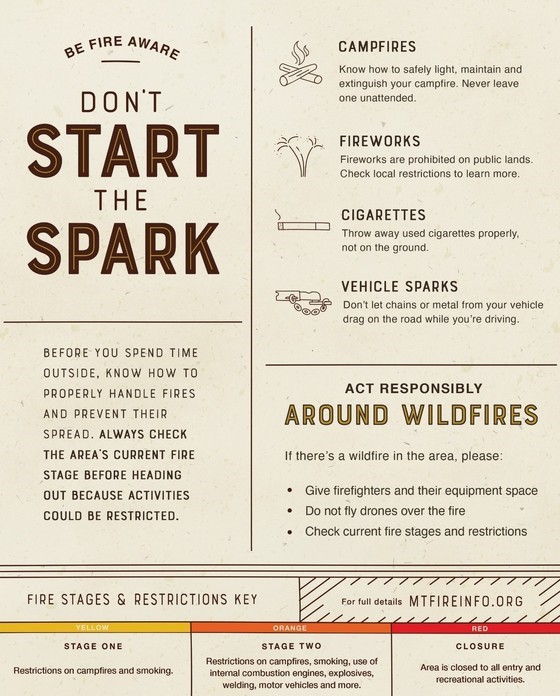
Montana Fire Restrictions
Under Stage 1 Restrictions, the following acts are prohibited:
- Building, maintaining, attending, or using a fire or campfire.
- Smoking, except within an enclosed vehicle or building, a developed recreation site or while stopped in an area at least three feet in diameter that is barren or cleared of all flammable materials.
Under Stage 2 Restrictions, the following acts are prohibited:
- Building maintaining, attending, or using a fire or campfire.
- Smoking, except within an enclosed vehicle or building, a developed recreation site, or while stopped in an area at least three feet in diameter that is barren or cleared of all flammable materials.
- Operating motorized vehicles off designated roads and trails.
- The following acts are prohibited from 1:00 pm to 1:00 am:
- Operating any internal combustion engine.
- Welding, or operating acetylene or other torch with an open flame.
- Using an explosive.
For more information on fire restrictions in the state of Montana, please refer to mtfireinfo.org.
Campfire Essentials
- Pick a safe campfire spot.
- Prepare your campfire pit.
- How to build a safe campfire.
- How to maintain and extinguish a campfire.
- Follow campfire rules.
- Never leave a campfire unattended or without adult supervision.
- Keep a bucket of water and shovel nearby.
- Never put anything but wood into the fire.
- Do not pull sticks out of the fire.
- Do not sit on the fire ring.
- Extinguish your campfire properly and completely before leaving your campsite.
- VIDEO: How to properly start, maintain and put out a campfire
- VIDEO: Campfire alternatives from Leave No Trace
Vehicles and Wildland Fire
Did you know that many wildland fires start from vehicle use? Remembering these hot tips will help you #RecreateResponsibly this summer:
- Exhaust can reach temperatures of 1000 + degrees, so avoid driving in or around dry grass.
- Unmaintained vehicles shoot hot particles. Make sure your car, truck or OHV is maintained and suited for off-road adventures. Brakes worn too thin may cause metal-to-metal contact, which can cause a spark.
- OHVs should have a spark arrestor. Drivers should pack a shovel and a bucket.
- Practice safe towing. Dragging chains throws sparks. Use appropriate safety pins and hitch ball to secure chains. Make sure your vehicle is properly maintained, with nothing dragging on the ground.
Montana Wildland Fire Resources
- Western Montana summer wildland fire updates: blog.glaciermt.com/western-montana-wildland-fire-update/
- Montana Wildland Fire Restriction Info: www.mtfireinfo.org/
- For up-to-date wildland fire information, visit https://inciweb.nwcg.gov/ or visit the National Interagency Fire Center: NIFC.gov
Additional Sources for Wildland Fire Prevention Practices
BE WILDLIFE WISE
Act Responsibly Around Wild Animals
Wildlife is just that—wild. It's important to act responsibly around wildlife, and it's also vital that, while recreating in the area, we help preserve and enhance wildlife habitat by practicing Leave No Trace principles.
- View wildlife from the safety of your car or from a safe distance. Stay at least 100 yards away from bears and at least 25 yards away from all other wildlife such as mountain goats or bison.
- Never approach, touch or feed wildlife, even when an animal does not seem to be threatened by your presence.
- Let wildlife know you're nearby. When hiking, be sure to bring a friend, carry bear spray, stay on designated trails and make noise at regular intervals.
Recreating in Bear Country
Many grizzly and black bears travel the forests, trails and terrain of Glacier Country. The grizzly bear is identified by a distinctive hump on its shoulders. Typically, its coat is dark brown, but can vary from very light cream to black. Grizzlies weigh between 400 and 1,500 pounds and can stand up to 8 feet tall on their hind legs. They also move very quickly and can reach speeds of up to 35 miles per hour. When recreating in bear country, it's important to follow and practice certain rules and guidelines.
- Stay 100 yards away from bears at all times.
- Carry bear spray and know how to use it.
- Hike in groups of three or more people.
- Don't hike at dawn, dusk or at night, when bears are most active.
- Don't use perfumes or scented body lotions.
- Be aware of your surroundings at all times. Most bears prefer to avoid people. When hiking, be sure to make noise such as clapping, whistling or singing so bears and other wildlife know you're coming.
- If you see a decomposing animal carcass or smell a strong odor, be sure to give a wide berth to the area, as bears are attracted to these smells.
- Never enter a closed trail.
- Camp in designated camping areas.
- Maintain a clean campsite. Be sure to store food in a bear-proof canister or hang it between trees at a height unreachable by bears.
- Be sure to pack out all garbage. Remember, even if it's an organic or biodegradable item—like an orange peel, apple core or cherry pit—it is not native to the forest and takes a long time to decompose. Plus, these are not foods animals find in their natural habitat and they can become sick if they eat them.
- Bear Encounters: Once a bear has noticed you and is paying attention to you, additional strategies can help prevent the situation from escalating. Read more from the National Park Service about bear encounters here.
- Remember that bears will fiercely defend their cubs. Don't come between a cub and a sow.
- Read more about bear safety from Be Bear Aware.
Read more about wildlife safety from Be Bear Aware.
RESPECT TRIBAL LANDS
Be Considerate in Sacred Places
It’s important to know when you are on tribal lands, and to be respectful while you’re there. Tribal communities welcome visitors, but keep in mind that this is not public land and there are sacred places we must not disturb. It’s also important to be mindful and respectful of a tribe’s unique culture, history and traditions. Make sure you “know before you go” in terms of permits and policies that may be different from Montana law. Here’s how to recreate responsibly while visiting an American Indian reservation in Western Montana.
The Blackfeet Reservation, home to the Blackfeet Nation, sits along the eastern edge of Glacier National Park encompassing nearly 1.5 million acres of rolling plains and Rocky Mountain Front. Located within reservation boundaries are the communities of Babb, Browning, East Glacier Park, Heart Butte and St. Mary, as well as Chief Mountain.
The Flathead Reservation, home to the Confederated Salish and Kootenai Tribes, encompasses 1.317 million acres in northwest Montana. Parts of Flathead Lake and the Bison Range are located within the reservation's boundaries, as are the communities of Arlee, Big Arm, Camas, Charlo, Dayton, Dixon, Elmo, Evaro, Hot Springs, Polson, Ravalli, Ronan and St. Ignatius.
Tribal Permits: If you plan to recreate (camp, fish, hunt, hike, boat) on tribal land, you will need a tribal permit. Visit Blackfeet Reservation and Flathead Reservation for more information. Please note, access to some areas on reservations may be prohibited to non-tribal members. Please respect and obey these areas, which should be marked with signage.
Pow wows: If you plan to attend a pow wow, please be aware of pow wow etiquette as not to disrespect the tribe. Taking photos is okay during most (but not all) events, though please try not to use flashes. Show respect by standing and removing your hat during songs or prayers conducted in honor of elders and veterans. If you are offered food and drink or even a small gift, it is considered polite to accept. Do not bring drugs or alcohol to a pow wow, and know that smoking tobacco at a pow wow may be considered disrespectful. Read more on page 19 of this guide.
Recreational Marijuana: Possessing and consuming marijuana on Indian Reservations in Montana is complicated and contingent on how federal marijuana laws may be enforced in Indian Country, as well as how each tribe approaches the question of marijuana legalization. Marijuana remains a Schedule 1 controlled substance under FEDERAL law, even though recreational marijuana has been legalized in Montana.
Native American Made in Montana: When looking to buy products made by American Indians, purchase items marked with the Native American Made in Montana symbol so you know you are getting authentic American Indian goods and supporting the tribes.
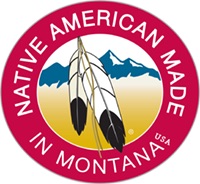
Blackfeet Reservation
Here’s a welcome message from Miss Blackfeet, Alia Heavy Runner.
About: For thousands of years, the Blackfeet have occupied the Rocky Mountain region. Originally nomads following the buffalo migration, the Blackfeet are made up of four bands—North Piegan, South Piegan, Blood and Siksika, though members of the Blackfeet Nation in the United States primarily descend from the South Piegan. The Blackfeet people honor the land and utilize it for cultural and spiritual purposes.
Tribal Permits: When camping, fishing, hunting, hiking and boating on tribal land, you will need a tribal permit. You can find more information here, and you can purchase permits online here.
Blackfeet Campgrounds: There are four campgrounds on the Blackfeet Reservation. Learn more and make reservations here. Be sure to secure a permit for camping on tribal land.
Follow the Blackfeet Nation: @visitblackfeet
Flathead Reservation
About: The Flathead Indian Reservation is home to the Confederated Salish and Kootenai Tribes, comprised of the Bitterroot Salish, Pend d'Oreille and Kootenai tribes. A rich oral history and a spiritual tradition of respect for the natural environment sustains the way of life for the tribes today.
Tribal Permits: When camping, fishing, hunting, hiking and boating on tribal land, you will need a tribal permit. You can find more information here; first-time permit buyers must purchase permits in person from a retail outlet listed on that page.
CSKT Campgrounds: There is one campground on the Flathead Reservation. Learn more here. Be sure to secure a permit for camping on tribal land.
For more information, go to csktribes.org.
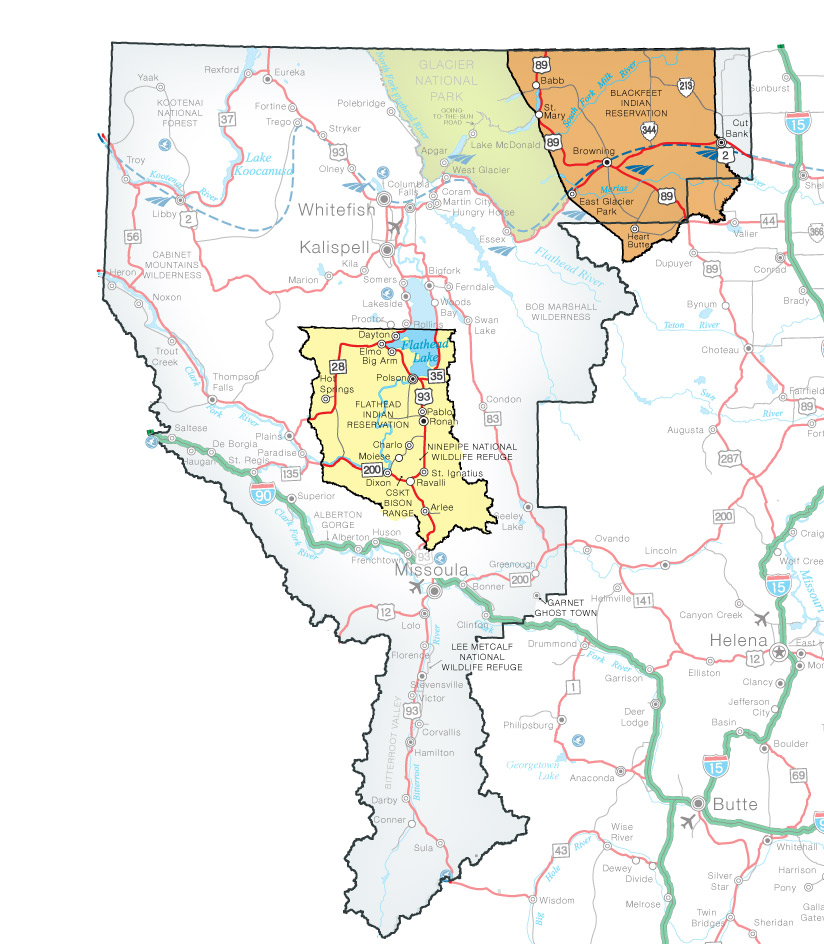
- Alberton
- Arlee
- Babb
- Big Arm
- Bigfork
- Bonner
- Browning
- Charlo
- Clinton
- Columbia Falls
- Condon
- Conner
- Coram
- Corvallis
- Cut Bank
- Darby
- Dayton
- De Borgia
- East Glacier Park
- Elmo
- Essex
- Eureka
- Evaro
- Ferndale
- Florence
- Fortine
- Frenchtown
- Greenough
- Hamilton
- Haugan
- Heron
- Hot Springs
- Hungry Horse
- Huson
- Kalispell
- Lakeside
- Libby
- Lolo
- Marion
- Martin City
- Missoula
- Moiese
- Noxon
- Olney
- Ovando
- Pablo
- Paradise
- Philipsburg
- Plains
- Polebridge
- Polson
- Proctor
- Ravalli
- Rexford
- Rollins
- Ronan
- Saltese
- Sčilíp
- Seeley Lake
- Somers
- St. Ignatius
- St. Mary
- St. Regis
- Stevensville
- Stryker
- Sula
- Superior
- Swan Lake
- Thompson Falls
- Trego
- Trout Creek
- Troy
- Victor
- West Glacier
- Whitefish
- Yaak
